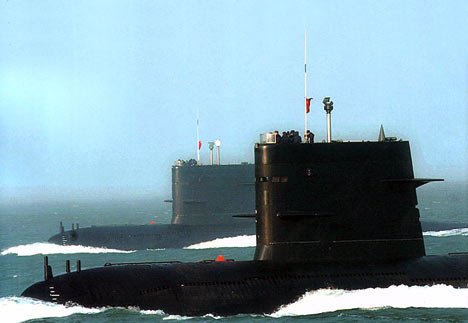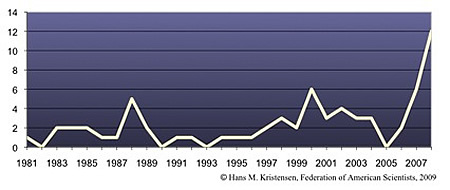Chinese Submarine Patrols Doubled in 2008
 |
| Chinese submarines conducted 12 patrols in 2008, the highest ever. |
.
By Hans M. Kristensen
Chinese attack submarines sailed on more patrols in 2008 than ever before, according to information obtained by Federation of American Scientists from U.S. naval intelligence.
The information, which was declassified by U.S. naval intelligence in response to a Freedom of Information Act request from the Federation of American Scientists, shows that China’s fleet of more than 50 attack submarines conducted 12 patrols in 2008, twice the number of patrols conducted in 2007.
China’s strategic ballistic missile submarines have never conducted a deterrent patrol.
Highest Patrol Rate Ever
The 12 patrols conducted in 2008 constitute the highest patrol rater ever for the Chinese submarine fleet. They follow six patrols conducted in 2007, two in 2006, and zero in 2005. China has four times refrained from conducting submarine patrols since 1981, and the previous peaks were six patrols conducted in 2000 and 2007 (see Figure 1).
|
Figure 1: |
 |
| Chinese attack submarines conducted 12 patrols in 2008, double the number from 2007. Yet Chinese ballistic missile submarines have yet to conduct a deterrent patrol. |
.
While the increase is submarine patrols is important, it has to be seen in comparison with the size of the Chinese submarine fleet. With approximately 54 submarines, the patrol rate means that each submarine on average goes on patrol once every four and a half years. In reality, the patrols might have been carried out by only a small portion of the fleet, perhaps the most modern and capable types. A new class of nuclear-powered Shang-class (Type-093) attack submarines is replacing the aging Han-class (Type-091).
Few of the details for assessing the implications of the increased patrol rate are known, nor is it known precisely what constitutes a patrol in order for U.S. naval intelligence to count it. A request for the definition has been denied. It is assumed that a patrol in this case involves an extended voyage far enough from the submarine’s base to be different from a brief training exercise.
In comparison with other major navies, twelve patrols are not much. The patrol rate of the U.S. attack submarine fleet, which is focused on long-range patrols and probably operate regularly near the Chinese coast, is much higher with each submarine conducting at least one extended patrol per year. But the Chinese patrol rate is higher than that of the Russian navy, which in 2008 conducted only seven attack submarine patrols, the same as in 2007.
Still no SSBN Patrols
The declassified information also shows that China has yet to send one of its strategic submarines on patrol. The old Xia, China’s first SSBN, completed a multi-year overhaul in late-2007 but did not sail on patrol in 2008.
 |
| Neither the Xia-class (Type-092) ballistic missile submarine (image) nor the new Jin-class (Type-094) have ever conducted a deterrent patrol. |
.
The first of China’s new Jin-class (Type-094) SSBN was spotted in February 2008 at the relatively new base on Hainan Island, where a new submarine demagnetization facility has been constructed. But the submarine did not conduct a patrol the remainder of the year. A JL-2 missile was test launched Bohai Bay in May 2008, but it is yet unclear from what platform.
Two or three more Jin-class subs are under construction at the Huludao (Bohai) Shipyard, and the Pentagon projects that up to five might be built. How these submarines will be operated as a “counter-attack” deterrent remains to be seen, but they will be starting from scratch.
Satellite imagery has long served as a tool for observing on-the-ground activity worldwide, and offers especially valuable insights into the operation, development, and physical features related to nuclear technology.
This report outlines a framework relying on “Cooperative Technical Means” for effective arms control verification based on remote sensing, avoiding on-site inspections but maintaining a level of transparency that allows for immediate detection of changes in nuclear posture or a significant build-up above agreed limits.
The grant comes from the Carnegie Corporation of New York (CCNY) to investigate, alongside The British American Security Information Council (BASIC), the associated impact on nuclear stability.
Satellite imagery of RAF Lakenheath reveals new construction of a security perimeter around ten protective aircraft shelters in the designated nuclear area, the latest measure in a series of upgrades as the base prepares for the ability to store U.S. nuclear weapons.